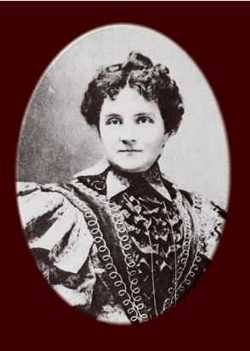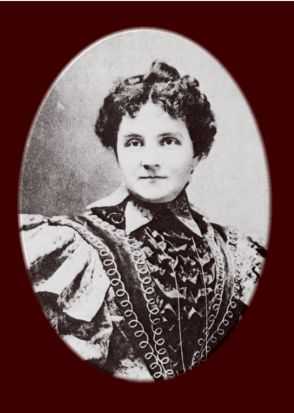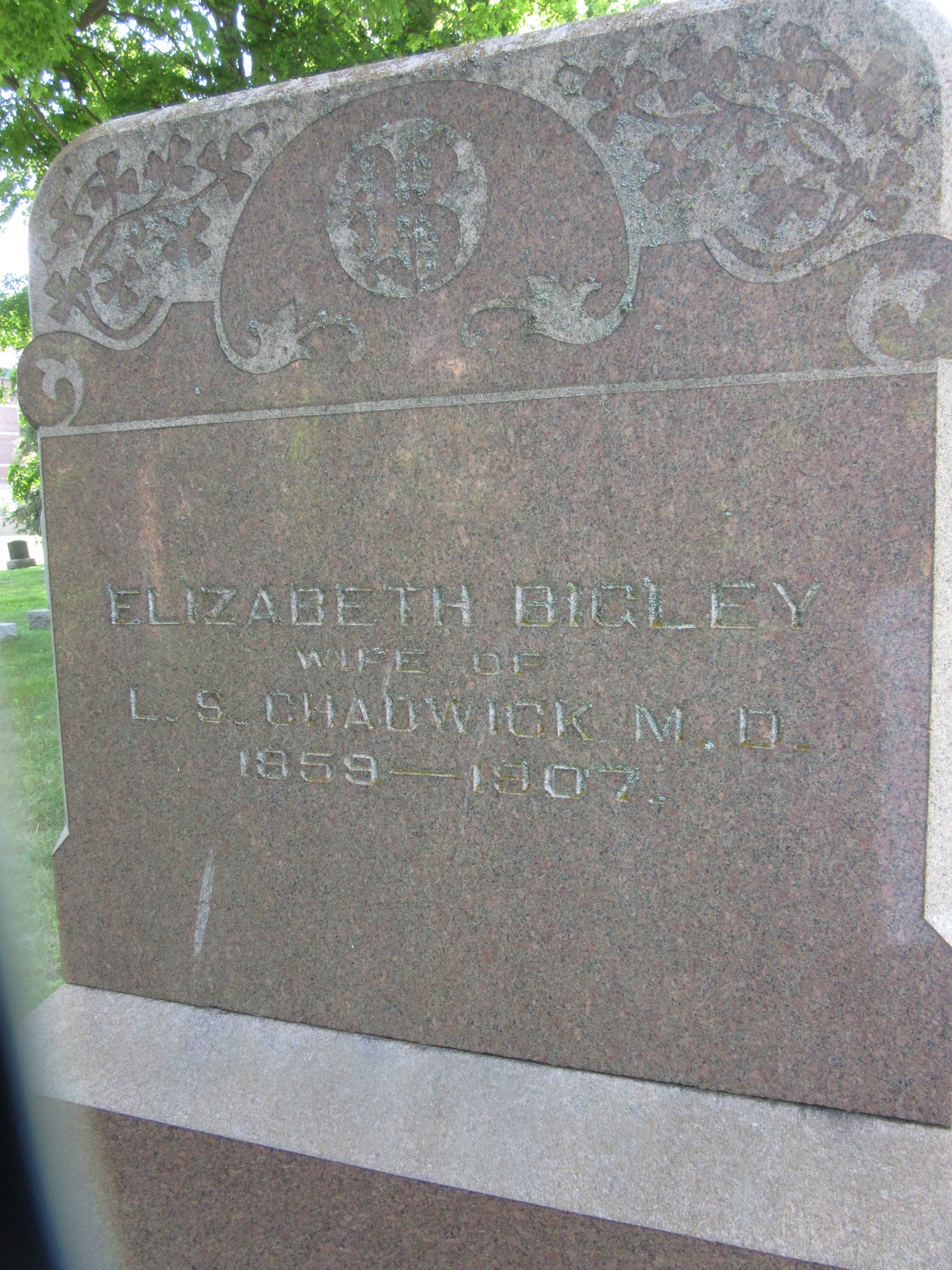Soon after, she changed her name to Lydia Scott and became a fortune-teller; only to change her name again to Madame Lydia de Vere, as it sounded better for a "clairvoyant." Some accounts say this happened in 1886 and 1887, respectively. One account says she was in San Francisco bilking unsuspecting people with her clairvoyance, then returned to Cleveland in 1886.
Most accounts state she was sentenced in 1889 to nine and a half years in the state penitentiary for forgery in Toledo. After serving four years, she was paroled by then-governor William McKinley, and returned to Cleveland. She changed her name yet again to 'Mrs. Hoover' and opened a brothel, or began working as a prostitute (accounts differ). At some point (one account says in 1887), she had a son, whom she named Emil Hoover.
It was around this point that she met and married Dr. Leroy S. Chadwick, a well-respected Cleveland physician, who most likely knew nothing of her past or criminal activities. Most accounts say this was in 1897; another account states they married in 1886. They apparently met at a bordello – either hers, which was said to be on the near West Side, or one on Euclid Avenue (again, sources vary) – with her assuring him she was merely an etiquette instructor for the girls. Another account says she presented herself as a respectable widow (to the widower Chadwick) who ran a respectable boarding house for women. When he responded that the place was a well-known brothel, she fainted and, upon recovery, begged him to take her from the place so no one would think she was complicit in its affairs.
It was apparently around this time that she changed her name to Cassie L. Chadwick. No mention is made as to what the "L" stands for. Nor does any account state specifically when or why she came up with this (first) name. She moved into the doctor's mansion on Euclid Avenue's "Millionaire's Row" and tried in vain to become part of the inner socialite circle. One account says the women at the brothel took care of the son, while other accounts don't make any mention of this.
All accounts concur that in 1897, Cassie set up her biggest scam. On a trip to New York City, in the posh lobby of the Holland House hotel, she was introduced to her husband's acquaintance, Dillon, who was an Ohio banker. One account says she told Dillon she was the illegitimate daughter of the wealthiest bachelor in America, Andrew Carnegie. To prove it, she and Dillon took a carriage ride to Carnegie's Fifth Avenue mansion. (Other accounts say she merely asked Dillon to take her there.)
While Dillon waited, Cassie went to the door and was admitted in, where she stayed for about 30 minutes. Upon returning to the carriage, she waved to a well-dressed man in the front window, then tripped while entering the carriage, surreptitiously dropping a piece of paper. Dillon retrieved this for her and noticed it was a promissory note for $2 million signed by Carnegie – whom Cassie said was the man waving from the window.
Dillon wanted details, which Cassie supplied – after swearing Dillon to secrecy. She said that Carnegie, out of shame for her illegitimacy, had given her promissory notes, worth $7 million, but with her own shame she had not drawn on them. She also said she would inherit $400 million when Carnegie died. In truth, the man in the window was the butler, whom Cassie had occupied by purporting to need credentials on a maid she intended to hire.
Upon returning to Ohio, Dillon set up a safe-deposit box for Cassie's promissory notes and then shared her ‘secret' with almost every lender in Northeast Ohio. Eager bankers began offering her loans of up to $1 million, with interest rates of 25 percent, believing millions were available to be gleaned. Instead of demanding repayment, they let Cassie's loans compound annually, figuring Carnegie would vouch for any debts and they would get their financial rewards after probate. According to one source, her husband was with her when she placed the promissory notes into the safe-deposit box at Wade Park National Bank in Cleveland. Nothing else is mentioned about her husband in any of the accounts.
Cassie then became known as the "Queen of Ohio." She bought diamond necklaces, clothes to fill 30 closets, and a gold organ for her living room. She entertained lavishly – even frittering $100,000 on a dinner party. For several years she lived the high life, amassing loan debts totaling $2-20 million. Again, accounts differ as to whether her debts totaled $2, $5, or $10-20 million; apparently no one knows exactly how much she had incurred. An Ashtabula newspaper account of her death stated: "The extent of these transactions will never be fully known, but they ran up into the millions. They involved men of high standing in the financial world and caused heavy losses to many bankers."
Banks were not the only ones to loan her money; millionaires did, too. And one of them was to be her downfall. Herbert B. Newton, a Boston, Massachusetts, banker or entrepreneur (accounts differ), loaned her $190,800 and had the gall to request repayment. Cassie was indignant. She explained that all of her securities (worth $10 million) were in the Wade Park bank. Newton went to the police and brought suit against her on November 2, 1904. Upon inspection, Cassie's promissory notes were found to be obvious forgeries.
News of the forgeries caused trouble for several Ohio banks. Citizen's National Bank of Oberlin, which had loaned Cassie $200,000, had a run that forced it into bankruptcy. When Carnegie was asked about his ‘daughter,' he issued a press release: "Mr. Carnegie does not know Mrs. Chadwick of Cleveland. … Mr. Carnegie has not signed a note for more than thirty years."
According to one source, Cassie was arrested on December 7, 1904, at her suite in Cleveland's Hotel Breslin – lying in bed with her money belt, containing $100,000. Other accounts say she fled to New York to the Holland House hotel but was soon arrested and returned to Cleveland. (One account says Dr. Chadwick and his adult daughter left hastily on a European vacation, but first he filed for divorce.)
Cassie stood trial in Cleveland; Andrew Carnegie even attended. On March 10, 1905, she was convicted on seven counts of conspiracy against the government and conspiracy to wreck the Citizen's National Bank of Oberlin. She was sentenced to 10 years according to two sources (14 years according to other sources), and fined $70,000. She brought trunks of finery to prison; animal skin rugs and clothes, which the warden let her keep. On January 1 or 12, 1906, she began her prison term, only to die less than two years later on her birthday, October 10, 1907.
According to the newspaper account, Cassie's health was already declining during her trial. It said: "She fretted incessantly over her confinement until it became almost impossible for her to sleep. At times she was so peevish the patience of the prison officials was sorely tried." While fairly robust when she entered prison, Cassie lost 30 pounds by the time of her death. Three weeks before, while visiting with her son (who was 20 years old), she suddenly collapsed and was confined to the prison hospital. She remained there until she died. At times she was delirious (although, the account said, she never talked of her criminal activities) and, for some hours before she actually passed away, was in a comatose state. Her son was summoned from Cleveland, but he arrived just 15 minutes after she died. Cassie Chadwick died at Ohio Penitentiary Hospital, Columbus, Ohio on her 50th birthday and was buried in her birthplace of Eastwood, Ontario, Canada.
Cassie was buried in the town of her birth: Eastwood, Ontario. Supposedly she had written to Emil several letters before her death; one of which asked him to get money from her hiding place to buy a tombstone for the family plot in Ontario.∼She married twice (?) and from first marriage had a son Emil Hoover.
Cassie married Leroy Chadwick in 1897 in Allegheny Co., PA.
There is a notation on a HS in Canada with her family... maybe be a cenotaph (#40200401) or this memorial needs to be merged with that one.
Family appears to have disowned her and son had no funds.
Second obit states likelihood of burial here.
Soon after, she changed her name to Lydia Scott and became a fortune-teller; only to change her name again to Madame Lydia de Vere, as it sounded better for a "clairvoyant." Some accounts say this happened in 1886 and 1887, respectively. One account says she was in San Francisco bilking unsuspecting people with her clairvoyance, then returned to Cleveland in 1886.
Most accounts state she was sentenced in 1889 to nine and a half years in the state penitentiary for forgery in Toledo. After serving four years, she was paroled by then-governor William McKinley, and returned to Cleveland. She changed her name yet again to 'Mrs. Hoover' and opened a brothel, or began working as a prostitute (accounts differ). At some point (one account says in 1887), she had a son, whom she named Emil Hoover.
It was around this point that she met and married Dr. Leroy S. Chadwick, a well-respected Cleveland physician, who most likely knew nothing of her past or criminal activities. Most accounts say this was in 1897; another account states they married in 1886. They apparently met at a bordello – either hers, which was said to be on the near West Side, or one on Euclid Avenue (again, sources vary) – with her assuring him she was merely an etiquette instructor for the girls. Another account says she presented herself as a respectable widow (to the widower Chadwick) who ran a respectable boarding house for women. When he responded that the place was a well-known brothel, she fainted and, upon recovery, begged him to take her from the place so no one would think she was complicit in its affairs.
It was apparently around this time that she changed her name to Cassie L. Chadwick. No mention is made as to what the "L" stands for. Nor does any account state specifically when or why she came up with this (first) name. She moved into the doctor's mansion on Euclid Avenue's "Millionaire's Row" and tried in vain to become part of the inner socialite circle. One account says the women at the brothel took care of the son, while other accounts don't make any mention of this.
All accounts concur that in 1897, Cassie set up her biggest scam. On a trip to New York City, in the posh lobby of the Holland House hotel, she was introduced to her husband's acquaintance, Dillon, who was an Ohio banker. One account says she told Dillon she was the illegitimate daughter of the wealthiest bachelor in America, Andrew Carnegie. To prove it, she and Dillon took a carriage ride to Carnegie's Fifth Avenue mansion. (Other accounts say she merely asked Dillon to take her there.)
While Dillon waited, Cassie went to the door and was admitted in, where she stayed for about 30 minutes. Upon returning to the carriage, she waved to a well-dressed man in the front window, then tripped while entering the carriage, surreptitiously dropping a piece of paper. Dillon retrieved this for her and noticed it was a promissory note for $2 million signed by Carnegie – whom Cassie said was the man waving from the window.
Dillon wanted details, which Cassie supplied – after swearing Dillon to secrecy. She said that Carnegie, out of shame for her illegitimacy, had given her promissory notes, worth $7 million, but with her own shame she had not drawn on them. She also said she would inherit $400 million when Carnegie died. In truth, the man in the window was the butler, whom Cassie had occupied by purporting to need credentials on a maid she intended to hire.
Upon returning to Ohio, Dillon set up a safe-deposit box for Cassie's promissory notes and then shared her ‘secret' with almost every lender in Northeast Ohio. Eager bankers began offering her loans of up to $1 million, with interest rates of 25 percent, believing millions were available to be gleaned. Instead of demanding repayment, they let Cassie's loans compound annually, figuring Carnegie would vouch for any debts and they would get their financial rewards after probate. According to one source, her husband was with her when she placed the promissory notes into the safe-deposit box at Wade Park National Bank in Cleveland. Nothing else is mentioned about her husband in any of the accounts.
Cassie then became known as the "Queen of Ohio." She bought diamond necklaces, clothes to fill 30 closets, and a gold organ for her living room. She entertained lavishly – even frittering $100,000 on a dinner party. For several years she lived the high life, amassing loan debts totaling $2-20 million. Again, accounts differ as to whether her debts totaled $2, $5, or $10-20 million; apparently no one knows exactly how much she had incurred. An Ashtabula newspaper account of her death stated: "The extent of these transactions will never be fully known, but they ran up into the millions. They involved men of high standing in the financial world and caused heavy losses to many bankers."
Banks were not the only ones to loan her money; millionaires did, too. And one of them was to be her downfall. Herbert B. Newton, a Boston, Massachusetts, banker or entrepreneur (accounts differ), loaned her $190,800 and had the gall to request repayment. Cassie was indignant. She explained that all of her securities (worth $10 million) were in the Wade Park bank. Newton went to the police and brought suit against her on November 2, 1904. Upon inspection, Cassie's promissory notes were found to be obvious forgeries.
News of the forgeries caused trouble for several Ohio banks. Citizen's National Bank of Oberlin, which had loaned Cassie $200,000, had a run that forced it into bankruptcy. When Carnegie was asked about his ‘daughter,' he issued a press release: "Mr. Carnegie does not know Mrs. Chadwick of Cleveland. … Mr. Carnegie has not signed a note for more than thirty years."
According to one source, Cassie was arrested on December 7, 1904, at her suite in Cleveland's Hotel Breslin – lying in bed with her money belt, containing $100,000. Other accounts say she fled to New York to the Holland House hotel but was soon arrested and returned to Cleveland. (One account says Dr. Chadwick and his adult daughter left hastily on a European vacation, but first he filed for divorce.)
Cassie stood trial in Cleveland; Andrew Carnegie even attended. On March 10, 1905, she was convicted on seven counts of conspiracy against the government and conspiracy to wreck the Citizen's National Bank of Oberlin. She was sentenced to 10 years according to two sources (14 years according to other sources), and fined $70,000. She brought trunks of finery to prison; animal skin rugs and clothes, which the warden let her keep. On January 1 or 12, 1906, she began her prison term, only to die less than two years later on her birthday, October 10, 1907.
According to the newspaper account, Cassie's health was already declining during her trial. It said: "She fretted incessantly over her confinement until it became almost impossible for her to sleep. At times she was so peevish the patience of the prison officials was sorely tried." While fairly robust when she entered prison, Cassie lost 30 pounds by the time of her death. Three weeks before, while visiting with her son (who was 20 years old), she suddenly collapsed and was confined to the prison hospital. She remained there until she died. At times she was delirious (although, the account said, she never talked of her criminal activities) and, for some hours before she actually passed away, was in a comatose state. Her son was summoned from Cleveland, but he arrived just 15 minutes after she died. Cassie Chadwick died at Ohio Penitentiary Hospital, Columbus, Ohio on her 50th birthday and was buried in her birthplace of Eastwood, Ontario, Canada.
Cassie was buried in the town of her birth: Eastwood, Ontario. Supposedly she had written to Emil several letters before her death; one of which asked him to get money from her hiding place to buy a tombstone for the family plot in Ontario.∼She married twice (?) and from first marriage had a son Emil Hoover.
Cassie married Leroy Chadwick in 1897 in Allegheny Co., PA.
There is a notation on a HS in Canada with her family... maybe be a cenotaph (#40200401) or this memorial needs to be merged with that one.
Family appears to have disowned her and son had no funds.
Second obit states likelihood of burial here.
Gravesite Details
Thank you to toothpick97 (48456813) for sharing middle name.
Family Members
Sponsored by Ancestry
Advertisement
Explore more
Sponsored by Ancestry
Advertisement










